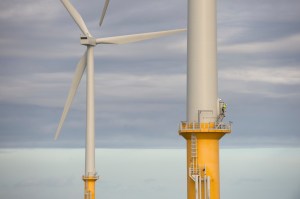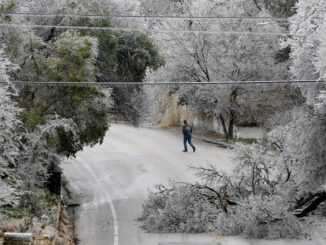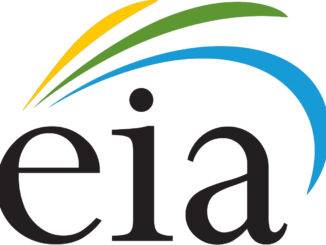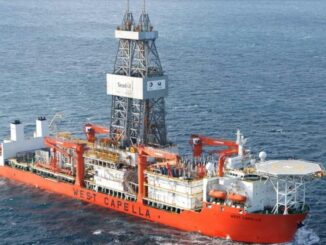
This article was originally published by Civil Eats.
Tom Hafer remembers the first time the fish stopped biting. It was a little over 20 years ago when fiber optic cables were being installed in waters off the coast of central California, where he fishes commercially for spot prawns and rockfish. The fishing was disrupted for “miles and miles,” says Hafer, who has been fishing since the 1970s.
Now, he and many other fishermen are bracing themselves for what could be a much larger threat looming in the water. Offshore wind farms, which are ramping up in the United States, could come at a tremendous cost to fishermen as they are being sited in prime fishing areas. And the process of erecting wind farms and their long-term presence in the water could alter aquatic ecosystems, potentially driving away fish and marine mammals.
Some fishing communities also believe the physical infrastructure of offshore wind farms may pose a danger to fishing vessels and gear and the people who earn a livelihood from the sea.
There is little science to assuage those concerns. The floating wind farms being proposed along the West Coast rely on technologies that haven’t yet been commercially deployed. And the federal agency tasked with siting new farms — the U.S. Bureau of Ocean Energy Management — is new to the task.
Sign up for Energy News Weekly
Get the most important energy news of the week delivered directly to your inbox.
Conceived in response to the BP oil spill in 2010, BOEM’s original charge was to oversee offshore oil in lieu of the former Minerals Management Service. BOEM has little experience with offshore wind and, so far, has been criticized for lack of thoroughness in vetting potential fishery conflicts.
Conflicts have also surfaced between BOEM and the nation’s top fisheries agency, NOAA Fisheries, as NOAA advises the agency in addressing concerns about fish health in an electrified sea. Recent reporting by ProPublica and The New Bedford Light has also raised concerns about relationships between the offshore wind industry and at least 90 of its regulators, including the deputy secretary of the Department of the Interior.
Offshore wind is a relatively new phenomenon in U.S. waters — the first commercial wind farm at sea was completed in 2016. That facility, Block Island Wind Farm, consists of five turbines off the coast of Rhode Island and is capable of producing 29 megawatts of power. That’s more than enough to supply all 17,000 homes on nearby Block Island, according to Ørsted, the Danish power company that acquired the installation in 2018.
But Block Island is a small fry compared to what’s coming, and that’s what has some critics worried. In 2021, the Biden administration set forth a lofty goal: By the end of the decade, it wants offshore wind farms to be producing 30 gigawatts of renewable energy in U.S. waters. Right now, Block Island and the two-turbine Coastal Virginia Offshore Wind pilot project are the only two commercial-scale facilities that have been completed, and together they’re capable of generating just 0.042 gigawatts, less than 1 percent of the Biden administration’s goal.
More than 2,000 turbines will likely be required to meet that goal, part of the administration’s efforts to address climate change, according to a 2022 report from the U.S. Department of Energy. That’s a massive ramp-up, says Sarah Schumann, who fishes commercially in Alaska and Rhode Island and coordinates the Fishery Friendly Climate Action campaign. “Within the last five years, the pace and scale of interest and development has exponentially increased. We’re really messing with the system in a way that we’ve never done before,” she says.
Fishermen ‘steamrolled’ by lack of engagement
In the coming years, offshore wind farms in the U.S. are slated to rise in the waters of the Atlantic, the Pacific, the Gulf of Mexico, and the Great Lakes. BOEM, part of the U.S. Department of the Interior, is responsible for leasing areas for offshore wind in federal waters. (Individual states have jurisdiction over nearshore waters within a few nautical miles of their coasts.) So far, BOEM has leased over 2.3 million acres — an area larger than the state of Delaware — of the so-called Outer Continental Shelf for potential wind farm development.
BOEM maintains that it engages with a wide variety of stakeholders, including commercial and recreational fishermen, to solicit input about the potential impacts of offshore wind facilities; last September, the organization announced that it was increasing the transparency of its process. It also partnered with NOAA Fisheries in December in a joint strategy to mitigate wind development’s impact on fisheries.
But some members of the fishing community maintain that the process of gathering feedback is inadequate and often feels perfunctory. “The federal process doesn’t provide any opportunity for meaningful stakeholder engagement and input,” says Lori Steele, executive director of the West Coast Seafood Processors Association, based in Astoria, Oregon. “We in the industry are feeling generally pretty steamrolled.”
Steele points to the situation in Oregon as an example. Last April, BOEM announced two “call areas” off the coast of Oregon being considered for potential wind farm development. One, located near Coos Bay along the central Oregon coast, measures roughly 105 by 60 kilometers; the other, located further south near Brookings, is about a third the size. Both areas begin roughly 14 miles off the coast.
The fishing industry in Oregon was blindsided by that announcement, says Steele. “We should have had a seat at the table for siting.” If BOEM had allowed fisheries to provide input, she says, sites could have been selected that would have less of an impact on Oregon fishers and their catches of Dungeness crab, pink fish, and sablefish. “The call areas that were chosen in Oregon overlap some of the primest fishing grounds that we have,” says Steele.
Defining call areas further offshore in deeper waters would have been better, says Steele, and that request was made, repeatedly, to BOEM after Oregon’s call areas were announced. Stakeholders, including Oregon’s previous governor, have explicitly asked that wind farms be sited in waters deeper than 1,300 meters. (The vast majority of Oregon’s two call areas are located in shallower waters.)
But that request has fallen on deaf ears, says Steele. “In the effort to try to work with BOEM to redesign or move the call areas, we’ve been entirely unsuccessful.”
Last month, the Pacific Fishery Management Council — which manages commercial, recreational, and tribal fisheries in federal waters along the entirety of the West Coast — passed a motion recommending that BOEM rescind both call areas off the coast of Oregon and commit to re-siting them while more thoroughly taking into account the needs of fisheries. On April 6, the council sent a formal letter to both BOEM and Oregon’s current governor outlining its requests.
Other groups like the Responsible Offshore Development Alliance have adopted a more aggressive tack when it comes to advocating for fisheries. In 2021, RODA sued BOEM for approving an 800-megawatt wind farm off the coast of Massachusetts.
BOEM did not respond to questions about the litigation. The agency also declined to provide a representative to be interviewed for this story but invited Civil Eats to send questions to its Office of Communications. Though BOEM provided links to online factsheets and press releases in response, the agency did not answer specific questions, including questions about how it engages with fisheries, despite five weeks of efforts by a reporter to learn more.
Environmental concerns beyond fisheries
People connected to the fishing industry aren’t just concerned about wind’s potential impact on fishing. They are also apprehensive about the effects of offshore wind farms on the marine environment. Digging trenches in the seafloor to bury the farms’ electrical cables creates noise that’s perceptible in the ocean ecosystem, and the process also churns up sediments.
Both processes are apt to disturb marine life, says Hafer, the president of the Morro Bay Commercial Fishermen’s Organization. Laying fiber optic cables back in the 1990s disrupted fishing around Morro Bay, and the future upheaval is bound to be worse because the cables have to be buried deeper, he says.
“We’ve already experienced how the fish stop biting,” adds Hafer.
Several fishers Civil Eats talked with also raised the point that marine life could be affected by the electromagnetic fields associated with submarine cables. That’s a valid concern, says Andy Lipsky, the Fisheries and Offshore Wind Lead at NOAA Fisheries at the Northeast Fisheries Science Center in Narragansett, Rhode Island, and it’s particularly true for species that rely on electric or magnetic fields for navigation such as salmon and tuna.
However, BOEM, which has the final say, maintains that the electrical cables associated with offshore wind energy projects won’t affect fish because the animals can’t perceive them. Instead, the agency asserted in a document about New England-area wind farms published in 2020, that the electromagnetic fields are “outside the known range of detection by electrosensitive and magnetosensitive fishes.”
There are also concerns about pile-driving. Most wind turbines off the East Coast are slated to be rigidly attached to the seafloor given the relatively shallow waters—a few dozen feet—near the Atlantic shoreline. That process often involves hammering one or more metal tubes several meters in diameter deep into the seafloor to serve as anchors. The resulting sound waves move through the water and through the sediments of the seafloor. Though science on the issue is slim, sounds akin to those of pile-driving have been shown to be capable of injuring fish, and mammals have been observed to avoid environments in which pile-driving is occurring.
“There’s a lot of concern how those acoustic impulses are going to impact marine mammals,” says Erin Meyer-Gutbrod, a marine ecologist at the University of South Carolina in Columbia. But it remains to be seen whether fish will flee as new offshore wind turbines are erected. That’s the fear of fishermen like Ed Barrett, who frequently fishes out of Plymouth, Massachusetts.
One study of Atlantic cod exposed to pile-driving noise from wind turbine construction in the North Sea revealed that the fish did not leave the noisy area. But there simply hasn’t been enough data collected over a long enough period of time to truly predict how fish will respond, says Lipsky. “There has been a lack of robust data on fishing interactions,” he adds.
One apprehension that some fishermen share seems to be unfounded: In the last few years, a spate of whale die-offs has been occurring in the Atlantic, and the mortality has recently been attributed to the use of sonar linked to offshore wind development. There’s no scientific basis to that assertion, says Meyer-Gutbrod. “There’s really no support for it.” Sonar has been used for decades to map the seafloor, she says, and the sound waves involved in the process aren’t likely to impact fish or mammals.
Some members of the fishing community are also worried about the risks that offshore wind farms might pose to human safety. Fishers are particularly concerned about floating installations; the majority of the wind turbines slated to rise in Pacific waters are planned to be floating rather than rigidly attached to the seafloor. (The continental shelf falls off steeply along much of the West Coast, and there are significant engineering challenges to installing turbines in waters deeper than about 200 feet.)
Preliminary designs — no commercial-scale floating wind facilities have been built yet — show a plethora of chains and other anchoring devices connecting floating platforms to the ocean bottom. All that anchoring infrastructure is a quagmire waiting to happen, says Schumann, who adds: “You’ll have chains going every which way.”
It’ll be difficult to safely navigate around everything in the water, let alone catch fish, says Alan Alward, a commercial fisherman based in Morro Bay, California, and a co-chair of the Alliance of Communities for Sustainable Fisheries. “It’s impossible to get your gear up and down.”
The apprehension that many fishermen are feeling about offshore wind is very justified, says Wesley Brighton, a fisherman based out of Martha’s Vineyard and New Bedford, Massachusetts, who fishes for scallops, squid, lobster, and crab. “There are so many unknowns.” Many small-scale fishers are already feeling the brunt of rising costs amid increased industry speculation. “We’re holding on by a thread,” says Brighton.
At the same time, he’s also hopeful about the future: Nine states along the East Coast have begun establishing compensation funds for fishermen whose livelihoods are affected by offshore wind development.
Time will tell how the rapid deployment of offshore wind proceeds, but it’s clear that the best way forward is to keep both sides — fishermen and the offshore wind community — talking to one another, says Brighton. “Real positive benefit is going to come from cooperation.”



